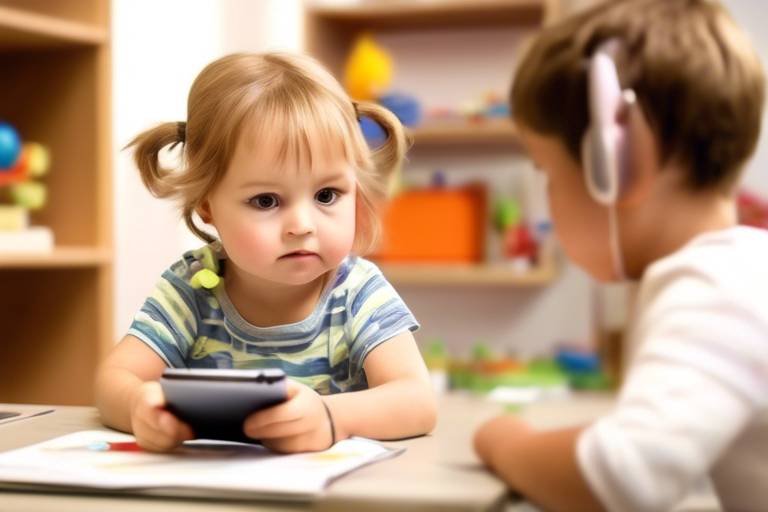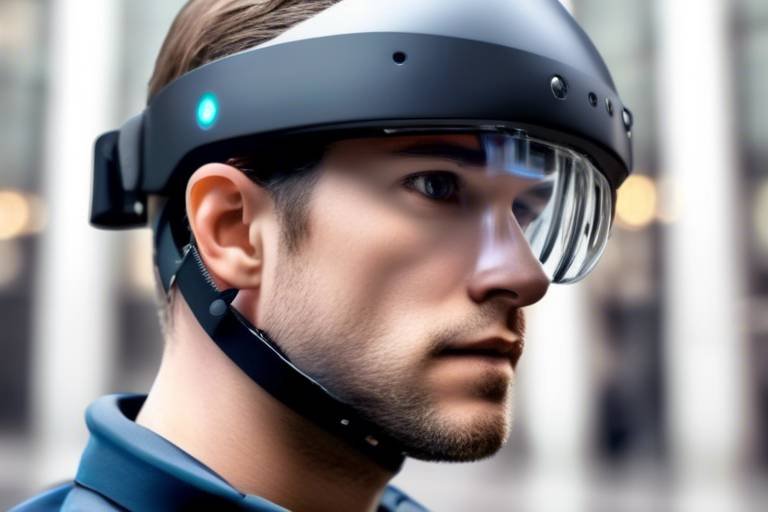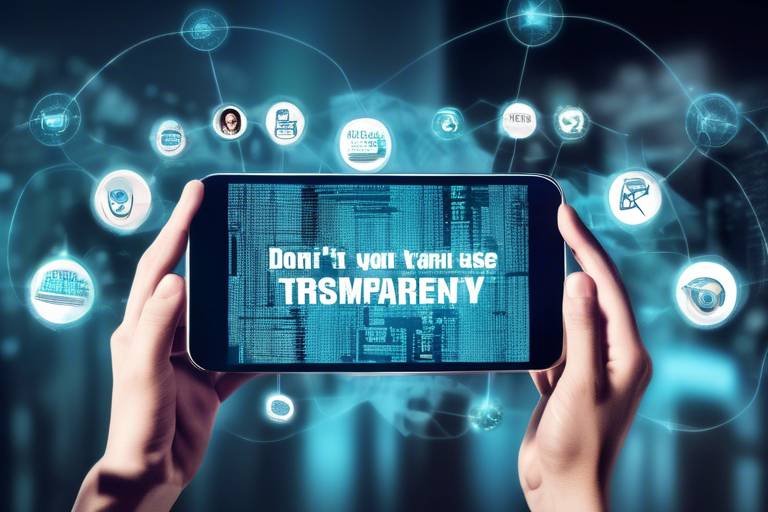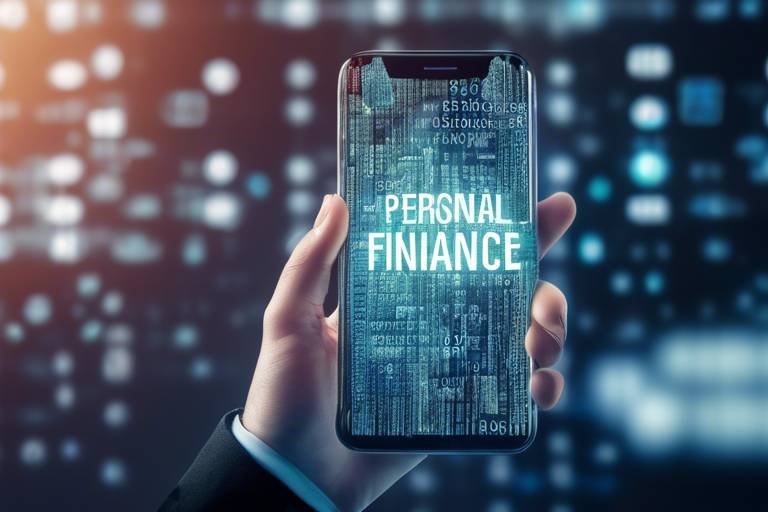Future Trends in EdTech - Gamification and Learning
The world of education is evolving at a breakneck pace, thanks to the advent of technology. Among the many innovations, gamification stands out as a transformative force that is reshaping how students engage with learning materials. Imagine a classroom where students are not just passive recipients of information but active participants in a thrilling game that rewards their efforts and achievements. This article dives deep into the future trends in educational technology, focusing on how gamification is not just a fad but a powerful tool that enhances learning experiences, boosts engagement, and improves educational outcomes.
Gamification is rapidly gaining traction in educational settings. It's like adding a sprinkle of excitement to the traditional learning process. By integrating game-like elements such as challenges, rewards, and interactive scenarios into the curriculum, educators are finding new ways to motivate students. The concept is simple yet impactful: when learning feels like a game, students are more likely to participate actively and enjoy the process. This trend is not just about making learning fun; it’s about creating an environment where students can thrive and develop a genuine love for knowledge.
The benefits of gamification for learners are numerous and compelling. First and foremost, it significantly increases engagement. When students are immersed in a game-like environment, they are more likely to stay focused and invested in their learning. This heightened engagement leads to improved retention of information, as students are actively participating rather than passively absorbing facts. Moreover, gamification transforms the learning process into a more enjoyable experience, which can reduce anxiety and foster a positive attitude toward education.
Central to the success of gamification are various game mechanics that foster competition and collaboration among students. Elements like points, badges, and leaderboards play a crucial role in motivating students. For instance, when students earn points for completing assignments or participating in discussions, they feel a sense of accomplishment that encourages them to continue striving for success. Badges serve as visual representations of their achievements, while leaderboards create a competitive atmosphere that can push students to excel. It’s like turning the classroom into a vibrant arena where learning becomes an exhilarating challenge.
Points and badges systems act as immediate rewards for accomplishments, encouraging students to strive for success. These systems can effectively influence student behavior and learning outcomes. For example, when a student earns points for completing a task or mastering a concept, they receive instant feedback that reinforces their effort. Badges, on the other hand, symbolize milestones achieved in their learning journey, providing a sense of progression. This gamified approach to education can transform mundane tasks into exciting challenges that students are eager to tackle.
Leaderboards create a competitive atmosphere that can drive students to perform better. The psychological effects of competition are profound; they can inspire students to push their limits and collaborate with peers to achieve common goals. However, it’s essential to strike a balance, as excessive competition can lead to anxiety and stress. By fostering a healthy competitive environment, educators can harness the motivating power of leaderboards while ensuring that collaboration remains a vital part of the learning experience.
Despite its many benefits, implementing gamification in education isn’t without challenges. Resource constraints, varying student responses, and the need for adequate training for educators can pose significant obstacles. Some students may not respond positively to gamified elements, while others may become overly competitive. To overcome these challenges, educators can adopt a flexible approach, tailoring gamification strategies to meet the diverse needs of their students. This may involve seeking feedback, adjusting game mechanics, and providing support to ensure that all students can benefit from the engaging learning environment that gamification offers.
The future of EdTech promises exciting innovations that will further enhance gamification strategies. As technology continues to advance, we can expect to see even more engaging and immersive educational experiences. Emerging technologies such as artificial intelligence (AI) and virtual and augmented reality (VR/AR) are set to revolutionize the way we approach gamified learning. These innovations will not only personalize educational journeys but also create interactive environments that make learning feel like an adventure.
Artificial intelligence is poised to take gamified learning to the next level by personalizing experiences and adapting to individual student needs. Imagine a learning platform that analyzes a student’s performance and adjusts challenges accordingly, ensuring that they are always engaged and appropriately challenged. This tailored approach can significantly enhance learning outcomes, making education more effective and accessible for everyone.
Virtual and augmented reality offer immersive learning experiences that can enhance gamification. These technologies can transform traditional education into engaging, interactive environments where students can explore complex concepts in a hands-on manner. For instance, a history lesson could become an exciting journey through ancient civilizations, allowing students to interact with the environment and learn in a way that textbooks simply cannot provide. As these technologies become more mainstream, we can expect gamified learning experiences to become even more dynamic and impactful.
- What is gamification in education? Gamification in education refers to the integration of game-like elements into learning to enhance student engagement and motivation.
- How does gamification improve learning outcomes? By making learning more enjoyable and interactive, gamification can lead to increased engagement, better retention of information, and improved overall educational performance.
- What are some common game mechanics used in education? Common game mechanics include points, badges, leaderboards, and challenges, all of which encourage competition and collaboration among students.
- What challenges do educators face when implementing gamification? Challenges include resource constraints, varying student responses, and the need for adequate training and support for educators.

The Rise of Gamification in Education
Gamification is not just a buzzword; it’s a revolution in the educational landscape that is reshaping how students engage with learning materials. Imagine a classroom where students are not just passive recipients of information but active participants in their own educational journey. This transformation is powered by the integration of game-like elements into traditional learning environments. The concept of gamification leverages the inherent fun and excitement of games to create a more engaging and motivating experience for learners.
Over the past few years, the popularity of gamification in education has skyrocketed. Schools and educational institutions are increasingly recognizing the need to adapt to the digital age, where students are accustomed to interactive and dynamic experiences. By incorporating elements such as points, badges, and leaderboards, educators can tap into students' natural competitive spirit and desire for achievement. This not only enhances motivation but also fosters a sense of community and collaboration among peers.
Research shows that gamified learning environments can lead to improved educational outcomes. For instance, a study published in the Journal of Educational Psychology found that students who participated in gamified learning experienced higher levels of engagement and retention compared to those in traditional settings. This is largely due to the way gamification transforms mundane tasks into exciting challenges. Instead of viewing homework as a chore, students see it as a quest to earn rewards and recognition.
Moreover, the rise of gamification aligns with the growing trend of personalized learning. By tailoring game mechanics to suit individual learning styles and preferences, educators can create a more inclusive educational experience. This adaptability is crucial, as it allows students to progress at their own pace, thereby catering to diverse learning needs. In this way, gamification is not just about making learning fun; it’s about making it effective and accessible for everyone.
As we look to the future, it’s clear that gamification will continue to play a pivotal role in education. With advancements in technology and a deeper understanding of how students learn, the potential for gamified learning experiences is limitless. From interactive simulations to collaborative challenges, the possibilities are endless. The question remains: are we ready to embrace this exciting shift and harness the power of gamification to foster a new generation of engaged learners?

Benefits of Gamification for Learners
Gamification is not just a buzzword; it’s a powerful tool reshaping how we approach education. By integrating game-like elements into the learning process, educators are able to create a more dynamic and engaging environment for students. But what exactly are the benefits of gamification for learners? Let’s dive into some of the most significant advantages that this innovative approach offers.
First and foremost, gamification significantly boosts engagement. Traditional learning methods can sometimes feel monotonous, leading to disengagement. However, when students are presented with challenges, rewards, and interactive experiences, they are more likely to immerse themselves in the learning process. Imagine a classroom where students are not just passively receiving information but are actively participating in quests, earning points, and competing in friendly challenges. This shift transforms learning into an adventure, making it exciting and enjoyable.
Another crucial benefit is improved knowledge retention. Studies have shown that when learners are actively involved in their education through gamified elements, they tend to remember information better. This is because gamification often involves repetition and practice, which are essential for mastering new concepts. For instance, a student who earns badges for completing levels in a learning game is likely to retain the information associated with those levels far better than if they simply read a textbook. It’s like learning to ride a bike; the more you practice, the better you get!
Moreover, gamification promotes a sense of accomplishment and motivation. When students achieve milestones, they receive instant feedback through points or badges, which can be incredibly motivating. This immediate recognition of effort encourages learners to continue striving for success. Think of it as climbing a mountain; each step you take is a small victory that propels you forward. This sense of achievement can lead to increased self-esteem and a stronger desire to learn.
Additionally, gamification fosters collaboration among students. Many gamified learning experiences are designed to encourage teamwork, where students must work together to solve problems or complete tasks. This collaborative spirit not only enhances social skills but also teaches valuable lessons about communication and cooperation. For example, consider a scenario where students form teams to complete a scavenger hunt that requires them to gather information from various sources. This not only makes learning fun but also strengthens their ability to work with others.
To summarize, the benefits of gamification for learners are profound and multifaceted. Here are some key advantages:
- Increased Engagement: Learning becomes an interactive adventure.
- Improved Retention: Active participation leads to better memory.
- Enhanced Motivation: Instant rewards fuel the desire to succeed.
- Collaboration Skills: Teamwork fosters social interaction and cooperation.
As educators continue to explore innovative ways to engage students, gamification stands out as a promising approach that can transform the educational landscape. By making learning fun and interactive, gamification not only enhances the educational experience but also prepares students for a future where adaptability and collaboration are key.
Q1: What is gamification in education?
A1: Gamification in education refers to the incorporation of game-like elements, such as points, badges, and challenges, into the learning process to enhance student engagement and motivation.
Q2: How does gamification improve learning outcomes?
A2: By making learning interactive and rewarding, gamification helps improve student engagement, retention of knowledge, and motivation, leading to better educational outcomes.
Q3: Can gamification be applied to all subjects?
A3: Yes, gamification can be applied across various subjects and educational levels, adapting to different learning styles and content areas.

Enhancing Engagement through Game Mechanics
When we think about engagement in education, it’s easy to picture students sitting quietly at their desks, diligently taking notes. But what if we could transform that image into one filled with excitement and enthusiasm? Enter the world of game mechanics! These elements, which are traditionally found in video games, have begun to infiltrate the classroom, creating a dynamic learning environment that captivates students like never before. By incorporating game mechanics such as points, badges, and leaderboards, educators can foster a sense of competition and collaboration that significantly enhances student engagement.
Imagine a classroom where students are not just passive recipients of information but active participants in their learning journey. With game mechanics, students are encouraged to take ownership of their education. For instance, when students earn points for completing assignments or participating in discussions, they are not merely checking off tasks; they are engaging in a rewarding experience that motivates them to strive for more. This immediate feedback loop can be incredibly powerful, as it taps into the natural human desire for recognition and achievement.
Moreover, the use of badges serves as a visual representation of a student’s accomplishments. Think of badges as digital trophies that students can showcase. When a student earns a badge for mastering a particular skill, it not only boosts their confidence but also encourages their peers to strive for similar recognition. This creates a culture of achievement where students support each other in reaching their goals. The psychological impact of earning badges can’t be understated; it fosters a sense of pride and accomplishment that drives students to engage more deeply with the material.
But what about the competitive edge? Enter leaderboards. These tools introduce a layer of friendly competition into the learning environment. When students see their names climbing the ranks, it can ignite a fire within them to perform better. This competitive atmosphere can be particularly effective in subjects that students may find challenging. The desire to improve their standing can motivate them to study harder and participate more actively. However, it’s essential to strike a balance; while competition can be beneficial, it’s crucial to ensure that it remains friendly and inclusive, fostering collaboration rather than discouraging those who may struggle.
To illustrate the effectiveness of these game mechanics, let’s take a look at a simple table that outlines their impact on student engagement:
| Game Mechanic | Impact on Engagement |
|---|---|
| Points | Encourages participation and completion of tasks. |
| Badges | Boosts motivation and provides visual recognition of achievements. |
| Leaderboards | Fosters healthy competition and encourages improvement. |
In conclusion, the integration of game mechanics into education is not merely a trend; it is a transformative approach that can significantly enhance student engagement. By leveraging points, badges, and leaderboards, educators can create a vibrant learning environment where students feel motivated to participate, collaborate, and succeed. As we move forward, it’s essential to continue exploring these innovative strategies to ensure that education remains exciting and relevant in an ever-evolving world.
- What is gamification in education? Gamification in education refers to the use of game-like elements, such as points, badges, and leaderboards, to enhance the learning experience and engage students.
- How does gamification improve student engagement? By introducing competition and reward systems, gamification motivates students to actively participate in their learning, making the process more enjoyable and effective.
- Are there any challenges to implementing gamification? Yes, challenges include resource constraints, varying student responses, and the need for proper training for educators to effectively integrate these strategies.
- What are some examples of game mechanics used in education? Common examples include point systems for completing tasks, badges for achievements, and leaderboards to track performance.

Points and Badges Systems
In the realm of gamification, have emerged as powerful tools that can significantly enhance student motivation and engagement. Imagine a classroom where students earn points for completing assignments, participating in discussions, or helping their peers. It’s like turning education into a thrilling game where every action counts, and every achievement is celebrated. These systems not only provide immediate feedback but also create a sense of accomplishment that can be incredibly motivating.
When students earn points, they can see their progress in real-time, which fuels their desire to learn and excel. Badges, on the other hand, serve as visual representations of achievements, much like trophies in a sports competition. They symbolize hard work and dedication, and students often take pride in showcasing their badges. This sense of pride can lead to a healthy competitive spirit, pushing students to strive for more. Just think about it—who wouldn’t want to display their accomplishments on a digital wall of fame?
However, it’s essential to design these systems thoughtfully. If points and badges are awarded too easily, they might lose their value. Conversely, if they are too difficult to obtain, students may feel discouraged. The key is to find a balance that encourages students to push their limits while still feeling a sense of achievement. A well-structured points and badges system can transform mundane tasks into exciting challenges, making learning a dynamic and enjoyable experience.
To illustrate the effectiveness of points and badges systems, consider the following table that outlines some common attributes and their impacts on student behavior:
| Attribute | Impact on Students |
|---|---|
| Points | Encourages participation and effort, providing immediate feedback and motivation. |
| Badges | Symbolizes achievement and recognition, fostering a sense of pride and accomplishment. |
| Levels | Creates a clear progression path, motivating students to advance and achieve more. |
| Challenges | Encourages collaboration and competition, enhancing engagement and learning outcomes. |
By implementing points and badges systems effectively, educators can create an environment where students are not just passive recipients of knowledge but active participants in their learning journey. The excitement of earning points and collecting badges can transform the educational experience, making it more interactive and enjoyable. Ultimately, these systems can lead to improved learning outcomes, as students become more invested in their education, striving to unlock new achievements and reach their full potential.
- What are points and badges systems? Points and badges systems are gamification tools that reward students for completing tasks, participating in activities, and achieving milestones.
- How do these systems motivate students? They provide immediate feedback and recognition, fostering a sense of accomplishment and encouraging further engagement.
- Can points and badges systems be misused? Yes, if not designed carefully, they can lead to unhealthy competition or disengagement if students feel overwhelmed or under-rewarded.
- What is the ideal balance for points and badges? The balance should ensure that achievements are challenging yet attainable, fostering motivation without leading to frustration.

Leaderboards and Competition
Leaderboards have emerged as a powerful tool in the realm of education, introducing a competitive edge that can significantly influence student engagement and performance. Imagine a classroom where students are not just passive learners but active participants, eager to climb the ranks and showcase their achievements. This competitive atmosphere can ignite a fire in students, pushing them to strive for excellence while fostering a sense of community among peers. But how exactly do leaderboards work their magic in educational settings?
At the heart of leaderboards lies the concept of competition. When students see their names listed alongside their peers, it creates a natural drive to improve. This can lead to increased effort and dedication, as students are motivated not only by their own progress but also by the desire to outperform others. However, it's essential to strike a balance; while competition can be a great motivator, it can also lead to stress and anxiety for some students. Therefore, educators must consider the individual differences in their classrooms and tailor their approaches accordingly.
One effective way to implement leaderboards is by incorporating various metrics that reflect different aspects of learning. For instance, instead of solely focusing on grades, leaderboards can include categories such as:
- Participation: Recognizing students who contribute to discussions or group projects.
- Improvement: Highlighting those who show significant growth over time.
- Collaboration: Acknowledging teamwork and peer support.
By diversifying the criteria for leaderboard rankings, educators can promote a more inclusive environment that values various strengths and encourages all students to engage. This approach not only enhances motivation but also cultivates a culture of collaboration rather than cutthroat competition.
Moreover, the psychological effects of competition can be profound. When students engage in a friendly rivalry, it can lead to improved self-esteem and a sense of accomplishment. They begin to associate learning with fun and excitement, making the educational process more enjoyable. However, it's crucial to monitor the impact of competition closely. Educators should be vigilant for signs of stress or discouragement among students and be ready to adjust the competition dynamics if necessary.
In conclusion, while leaderboards can be an excellent tool for fostering competition and engagement in the classroom, they must be implemented thoughtfully. By considering the diverse needs of students and creating a balanced competitive environment, educators can harness the power of leaderboards to enhance learning outcomes and create a vibrant educational experience.
- What are the benefits of using leaderboards in education?
Leaderboards can enhance student motivation, foster a sense of community, and encourage healthy competition, which can lead to improved learning outcomes. - How can I implement leaderboards effectively?
Consider using diverse metrics for rankings, focusing on various aspects of learning, and maintaining a supportive environment to ensure all students feel valued. - Can competition negatively impact some students?
Yes, competition can lead to stress for some students. It's essential to monitor student responses and adjust the competitive elements as needed.

Challenges of Implementing Gamification
While gamification in education offers a plethora of benefits, it doesn't come without its challenges. One of the primary obstacles educators face is resource constraints. Implementing gamified systems often requires additional tools, software, and training, which can strain budgets and time. Schools may find themselves grappling with outdated technology or a lack of necessary infrastructure to support these innovative approaches. The question arises: how can educators effectively integrate gamification without breaking the bank?
Another significant challenge is the varied student responses to gamification. Not every student is motivated by competition or rewards. Some may feel overwhelmed by the pressure of leaderboards or may not respond positively to point systems. This disparity in student engagement can lead to frustration among learners who might feel left out or demotivated. Educators must find a balance, ensuring that gamification strategies are inclusive and cater to diverse learning styles.
Furthermore, teacher training plays a crucial role in the successful implementation of gamification. Many educators are not familiar with game mechanics or how to effectively incorporate them into their curriculum. Without proper training, teachers might struggle to utilize gamification to its full potential, leading to ineffective or poorly executed strategies. Investing in professional development is essential for equipping educators with the skills they need to create engaging, gamified learning experiences.
To address these challenges, schools can consider collaborative approaches. By pooling resources with other institutions or seeking partnerships with technology providers, schools can mitigate some financial burdens. Additionally, involving students in the design of gamified elements can create a more tailored experience, ensuring that the systems resonate with their interests and motivations. Ultimately, successful gamification in education requires a thoughtful approach that considers both the benefits and the hurdles.
- What is gamification in education? Gamification in education refers to the integration of game-like elements, such as points, badges, and leaderboards, into the learning process to enhance student engagement and motivation.
- How can gamification benefit students? Gamification can improve student engagement, retention, and overall enjoyment of the learning process, making education more interactive and fun.
- What challenges do educators face when implementing gamification? Challenges include resource constraints, varied student responses, and the need for teacher training to effectively use gamified strategies.
- How can schools overcome resource constraints for gamification? Schools can collaborate with other institutions, seek partnerships with technology providers, and involve students in the design process to share resources and ideas.

Future Innovations in EdTech
The future of educational technology (EdTech) is brimming with potential, and one of the most exciting aspects is how gamification will evolve. As we move forward, we can expect to see a plethora of innovations that will not only enhance the learning experience but also make education more engaging and effective. Imagine a classroom where students are not just passive recipients of information but active participants in their learning journey, driven by game-like mechanics that keep them motivated and excited. This transformation is already underway, and it's just the tip of the iceberg.
One of the most promising innovations on the horizon is the integration of artificial intelligence (AI) into gamified learning environments. AI has the potential to revolutionize how we approach education, allowing for a more personalized experience tailored to each student's unique needs. For instance, AI can analyze a student's performance in real-time, identifying strengths and weaknesses, and then adapting the learning materials accordingly. This means that no two students will have the same learning path; instead, they will have customized journeys that keep them engaged and challenged. With AI, the possibilities for personalized education are limitless!
Moreover, the incorporation of virtual reality (VR) and augmented reality (AR) into educational settings is set to create immersive experiences that can dramatically transform traditional learning. Picture this: instead of reading about ancient civilizations in a textbook, students can step into a virtual world where they can explore historical sites, interact with avatars of historical figures, and experience life as it was back then. This kind of immersive learning not only captivates students' attention but also enhances their understanding and retention of complex concepts. The use of VR and AR can make learning feel like a thrilling adventure rather than a chore.
To further illustrate these innovations, consider the following table that highlights the key features and benefits of AI, VR, and AR in EdTech:
| Technology | Key Features | Benefits |
|---|---|---|
| Artificial Intelligence | Personalization, Real-time feedback, Adaptive learning | Tailored learning experiences, Improved student outcomes, Enhanced engagement |
| Virtual Reality | Immersive environments, Interactive simulations | Enhanced understanding, Increased motivation, Real-world applications |
| Augmented Reality | Overlaying digital information on the real world, Interactive learning objects | Engagement through interactivity, Bridging theory and practice, Visual learning |
As we look to the future, we can also anticipate the rise of collaborative learning platforms that leverage gamification to foster teamwork and communication skills among students. These platforms will encourage students to work together on projects, solving problems in a game-like environment that rewards collaboration and creativity. Imagine students from different corners of the globe teaming up to tackle real-world challenges, all while enjoying the process and earning points for their contributions. This kind of global collaboration not only prepares students for the workforce but also cultivates a sense of community and shared purpose.
In summary, the future of EdTech is incredibly bright, with innovations like AI, VR, and AR set to redefine how we approach learning. By embracing these technologies and integrating gamification into educational practices, we can create a more engaging, personalized, and effective learning environment for all students. The possibilities are endless, and as educators, we must be ready to adapt and embrace these changes to provide our students with the best possible educational experiences.
- What is gamification in education? Gamification in education refers to the integration of game-like elements, such as points, badges, and leaderboards, into the learning process to enhance student engagement and motivation.
- How does AI improve learning experiences? AI personalizes learning by adapting educational content to meet the individual needs of students, providing real-time feedback, and identifying areas for improvement.
- What are the benefits of using VR and AR in education? VR and AR create immersive learning experiences that enhance understanding, increase motivation, and provide real-world applications of theoretical concepts.

Artificial Intelligence in Gamified Learning
Artificial Intelligence (AI) is not just a buzzword; it's a game-changer in the realm of gamified learning. Imagine walking into a classroom where each student's learning experience is tailored specifically to their needs. That's the magic of AI! By leveraging data and algorithms, AI can analyze a student's performance in real-time, adjusting the difficulty of tasks and providing personalized feedback. This means that students who may struggle with certain concepts can receive additional resources and challenges suited to their pace, while advanced learners can be pushed further to keep them engaged. It’s like having a personal tutor available 24/7!
Furthermore, AI can enhance the gamification elements of educational platforms. For instance, AI algorithms can determine which game mechanics resonate most with individual students, whether it’s earning points for completing tasks, unlocking badges for achievements, or climbing up a leaderboard. By understanding what motivates each student, educators can create an environment that maximizes engagement and learning outcomes.
One of the most exciting aspects of AI in gamified learning is its ability to predict future performance. By analyzing past behaviors and achievements, AI can forecast areas where students might struggle, allowing educators to intervene proactively. This predictive capability not only enhances the learning experience but also helps in designing curricula that can adapt over time. In essence, AI acts as a compass, guiding both students and educators through the vast sea of knowledge.
As we look ahead, the integration of AI in gamified learning environments will likely expand. We might see systems that utilize natural language processing to facilitate real-time conversations between students and AI tutors, making learning more interactive and engaging. Imagine a scenario where a student can ask questions and receive instant, contextual answers while playing an educational game. This kind of interaction can transform the way we perceive learning, making it feel less like a chore and more like a quest!
However, the implementation of AI in education is not without its challenges. There are concerns regarding data privacy and the ethical use of AI. It’s crucial for educational institutions to navigate these waters carefully, ensuring that students' data is protected while still reaping the benefits of AI-driven personalized learning experiences. The future of education lies in finding that balance, and with the right approach, AI can indeed pave the way for a more engaging and effective learning journey.
- What is gamified learning? Gamified learning incorporates game design elements in educational settings to enhance student engagement and motivation.
- How does AI enhance gamified learning? AI personalizes the learning experience by analyzing student performance and adapting challenges to fit individual needs.
- What are some examples of AI in education? Examples include intelligent tutoring systems, adaptive learning platforms, and AI-driven assessments that provide immediate feedback.
- Are there any challenges with using AI in education? Yes, challenges include data privacy concerns and ensuring equitable access to technology for all students.

Virtual and Augmented Reality Experiences
Imagine stepping into a classroom where the walls dissolve into a vibrant world filled with dinosaurs, planets, or even historical events. Virtual Reality (VR) and Augmented Reality (AR) are not just technological gimmicks; they are reshaping how we think about education. These immersive experiences allow students to engage with content in ways that traditional methods simply can't match. The moment you put on a VR headset or view AR content through your smartphone, you’re not just learning; you’re living the experience. This kind of engagement can transform mundane lessons into thrilling adventures.
One of the most exciting aspects of VR and AR in education is their ability to create interactive environments. For instance, students studying biology can explore the human body in 3D, examining organs and systems as if they were performing surgery, all without the risk of real-life consequences. Similarly, history students can walk through ancient civilizations, seeing and interacting with their surroundings, which fosters a deeper understanding of the material. This hands-on approach not only makes learning more enjoyable but also enhances retention, as students are likely to remember experiences more vividly than facts from a textbook.
Furthermore, the integration of VR and AR into educational settings can cater to various learning styles. Visual learners can benefit from the stunning graphics of VR, while kinesthetic learners can engage with AR applications that require physical interaction. This versatility means that educators can reach a wider range of students, ensuring that everyone has the opportunity to thrive. Not to mention, these technologies can be particularly beneficial for students with disabilities, providing customized learning experiences that cater to their unique needs.
However, the implementation of VR and AR in education is not without its challenges. Schools often face budget constraints that make it difficult to acquire the necessary technology. Moreover, educators need training to effectively integrate these tools into their teaching. To address these challenges, schools can consider partnerships with tech companies or seek grants specifically aimed at enhancing educational technology. By working together, we can create a future where immersive learning experiences are accessible to all students.
As we look ahead, the potential for VR and AR in education is limitless. Imagine a world where students can travel through time, explore the depths of the ocean, or even experience life on another planet—all from the comfort of their classroom. The future of education is not just about learning facts; it’s about experiencing knowledge in a way that is engaging, memorable, and effective. As these technologies continue to evolve, we can expect even more innovative applications that will further transform the educational landscape.
- What is the difference between Virtual Reality and Augmented Reality?
Virtual Reality immerses users in a completely virtual environment, while Augmented Reality overlays digital content onto the real world. - How can VR and AR enhance learning?
These technologies provide immersive experiences that engage students, making learning more interactive and enjoyable, which can lead to better retention of information. - Are there any challenges associated with implementing VR and AR in education?
Yes, challenges include budget constraints, the need for educator training, and ensuring accessibility for all students. - What subjects can benefit from VR and AR?
Subjects like science, history, and geography can greatly benefit from these technologies, as they allow for immersive exploration and interaction with content.
Frequently Asked Questions
- What is gamification in education?
Gamification in education refers to the integration of game-like elements into the learning process. This includes using points, badges, leaderboards, and other mechanics to enhance student engagement and motivation. By making learning more interactive and fun, gamification aims to improve educational outcomes.
- How does gamification improve student engagement?
Gamification boosts student engagement by introducing elements of competition and collaboration. When students earn points or badges, they feel a sense of accomplishment that motivates them to participate more actively. Leaderboards can also create a healthy competitive spirit, encouraging students to strive for better performance.
- What are the benefits of gamification for learners?
Gamification offers several benefits, including increased engagement, improved retention of information, and a more enjoyable learning experience. By turning lessons into games, students are more likely to stay focused and retain what they've learned, making education feel less like a chore and more like an adventure.
- What challenges do educators face when implementing gamification?
While gamification has many advantages, educators may encounter challenges such as limited resources, varying student responses, and the need for training in new technologies. It's essential for educators to find solutions to these challenges, such as starting with small gamified elements and gradually expanding their use.
- How will artificial intelligence impact gamified learning?
Artificial intelligence is set to revolutionize gamified learning by personalizing educational experiences. AI can analyze individual student performance and adapt the learning journey to meet their specific needs, ensuring that each student receives the support and challenges they require to succeed.
- Can virtual and augmented reality enhance gamification?
Absolutely! Virtual and augmented reality can create immersive learning environments that make gamification even more engaging. These technologies allow students to experience lessons in a hands-on way, transforming traditional education into interactive adventures that captivate their interest.


















